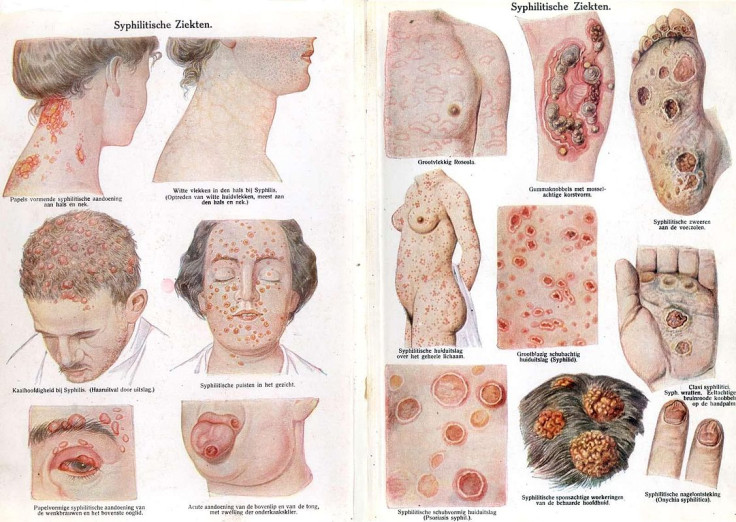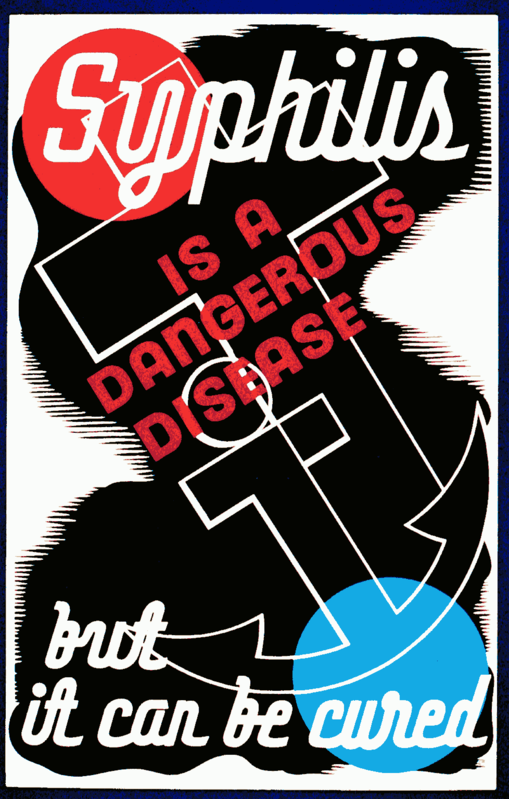Valentine's Day 2016: 'A night with Venus, a lifetime with mercury', the history of sexually transmitted diseases

As Valentine's Day dawns, which for many is the most romantic night of the year, IBTimes UK looks at the unwelcome side to love through the ages. Sexually transmitted diseases have been around for centuries, with historical documentation dating back to at least 2,000 years ago with the Ebers papyrus, from around 1550BC. This ancient Egyptian document of herbal knowledge contains some of the first treatments for venereal disease.
They include treatment of discharges with preparations of garlic, acanthus resin, cow horn and the grist of vegetable seeds combined with oil. This concoction was then put on a sponge and placed into the vagina. In the case of men, circumcision was advised to prevent venereal diseases.
In the time of the Romans, the physician Aulus Cornelius Celsus who practised medicine during the reign of Tiberius (14-37AD), copper and its derivatives were an important drug in the medical practitioner's pharmacopoeia. In Celsus's series, De Medicina, for the treatment of venereal disease, a remedy was prescribed for venereal complaints consisting of pepper, myrrh, saffron, cooked antimony sulfide and copper oxide.
Women in classical times practised frequent vaginal lavage, while men used the contents of a small oil bottle after visiting a brothel. The Roman historian Pliny is said to have carried a sheep appendix or fish bladder – the predecessor of the condom – in a fold of all his togas in order to prevent infections.
Chinese medical literature under the Tang Dynasty (618-906AD) wrote of gonorrhoea-type diseases, with symptoms including chronic ulcers of the genitals. Doctors prescribed sarsaparilla and quicksilver as remedies for syphilitic chancres. The name for venereal disease in China was Guangchuang or plum-blossom sores as the pustules bore a resemblance to the flower.

The first recorded European outbreak of what is now known as syphilis occurred in 1494 when it broke out among French troops besieging Naples in the Italian War of 1494–1498. From Naples, the disease swept across Europe, killing more than five million people.
As anthropologist Jared Diamond describes it, "[W]hen syphilis was first definitely recorded in Europe in 1495, its pustules often covered the body from the head to the knees, caused flesh to fall from people's faces, and led to death within a few months."
In medieval times, syphilis and gonorrhoea were two of the most prevalent STDs in Europe. One theory is that syphilis was spread by crew members who picked up the disease on voyages led by Christopher Columbus. The sailors then spread it in the Americas and then on to ports in Europe.
Casanova, the great lover
The memoirs of Giacomo Casanova, one of the most famous lovers in history, provide insight into the transmission and treatment of sexually transmitted disease in Europe in the 18th century. In 1760 Casanova contracted a severe case of syphilis from one of his lovers, who "gave me a disease, which devoured her interior parts and left no marks outwardly, and was thus all the more dangerous, as the freshness of her complexion seemed to indicate the most perfect health."
Casanova wrote that he treated his infections with a combination of mercury and diet (either fasting or consuming certain prescribed foods), and the memoir goes into great detail about his treatment from a doctor named Cephalides: "He examined me and declared he could cure me by sudorifics without having recourse to the knife. He began his treatment by putting me on a severe regimen, ordering baths, and applying mercury locally.
"I endured this treatment for six weeks, at the end of which time I found myself worse than at the beginning. I had become terribly thin, and I had two enormous inguinal tumours. I had to make up my mind to have them lanced, but though the operation nearly killed me, it did not make me any better."
Kill or cure
Syphilis can cause severe, life-altering consequences such as destruction of the brain and spinal cord, leading to mental dysfunction, hallucinations and speech problems. A lack of awareness and understanding of STDs contributed to the transmission of infections, with few treatments - and those that did exist sometimes caused the death of the suffering.
Treatment in the 18th and 19th centuries included mercury, arsenic and sulphur, but many people died of mercury poisoning. As Lesley Hall of the Wellcome Trust put it: "A night with Venus, a lifetime with mercury."
She adds: "It [venereal disease] was long believed to be generated by toxic substances in the genital tracts of promiscuous women communicated to their male partners. 'Gleet,' a persistent discharge, or stricture of the urethra, could result from repeated reinfection."
In 1746, the first treatments for venereal disease were available at the London Lock Hospital. The first known effective treatment for syphilis was Salvarsan or arsphenamine which was introduced in 1910.
It was only in the 20th century with the discovery of penicillin and other antibiotics that led to an effective cure for STDs. However, resistance to sexually transmitted infections (STIs), particularly gonorrhoea, has reduced treatment options. 'Last resort' treatment such as oral and injectable cephalosporins is making gonorrhoea a multi drug-resistant organism.
© Copyright IBTimes 2025. All rights reserved.






















